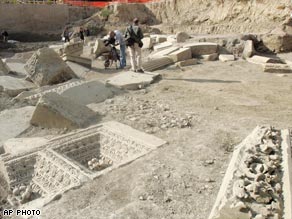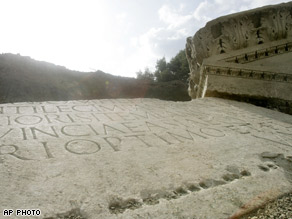 |
ROME, Italy (AP) -- Workers renovating a rugby stadium have uncovered a vast complex of tombs beneath Rome that mimic the houses, blocks and streets of a real city, according to officials, who have unveiled a series of new finds.
Culture Ministry officials said Thursday that medieval pottery shards in the city of the dead, or necropolis, show the area may have been inhabited by the living during the Dark Ages after being used for centuries for burials during the Roman period.
|
It is not yet clear who was buried in the ancient cemetery, but archaeologists at the still partially excavated site believe at least some of the dead were freed slaves of Greek origin.
"It's a matter of a few weeks to discover what is down there," said archaeologist Marina Piranomonte. "But it's something big; it looks like a neighborhood."
A separate dig in the north of the city has turned up the tomb of a nobleman who led Rome's legions in the second century A.D.
The mausoleum was covered in mud during a flood of the river Tiber, which collapsed most of the monument but helped preserve exquisite decorations, marble columns and inscriptions from plunderers and the ravages of time.
Writings at the site led experts to identify the tomb as belonging to Marcus Nonius Macrinus, one of the closest aides and generals of the Emperor Marcus Aurelius during his campaigns against Germanic tribes in Northern Europe.
 |
Other spectacular discoveries were also unveiled at the news conference at the Culture Ministry.
Archaeologists restoring the imperial residences on the Palatine Hill, in the heart of ancient Rome, believe they have discovered the underground passageway in which the despotic Emperor Caligula was murdered by his own guards.
The hill, which his honeycombed with ruins of palaces and villas, has also yielded frescoes and black-and-white mosaics in the first century B.C. home of a patrician, the ministry said in a statement. |
Separately, experts working in Castel di Guido on the outskirts of Rome have enlarged their dig at a previously known complex of country villas owned by Rome's rich and powerful, uncovering fountains, baths and a cistern, the statement said.
Archaeologists will keep working at the digs to make them accessible to visitors. Officials plan to build a museum next to Macrinus' tomb, which will also offer a virtual reconstruction of the site.
Liked it ? Want to share it ? Social Bookmarking
Discuss this on forum ||
Article Link ||
Source : Website
||
Return to Unexplained Mysteries
|







